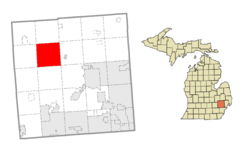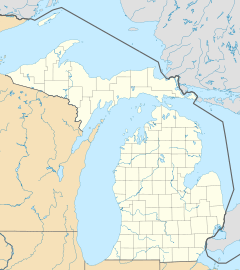Springfield Township, Oakland County, Michigan facts for kids
Quick facts for kids
Springfield Township, Michigan
|
|
|---|---|
|
Charter township
|
|
| Springfield Charter Township | |
| Motto(s):
"Come Home to Springfield Township"
|
|

Location within Oakland County
|
|
| Country | United States |
| State | Michigan |
| County | Oakland |
| Established | 1836 |
| Area | |
| • Charter township | 36.7 sq mi (95.2 km2) |
| • Land | 35.6 sq mi (92.2 km2) |
| • Water | 1.2 sq mi (3.0 km2) |
| Elevation | 1,017 ft (310 m) |
| Population
(2020)
|
|
| • Charter township | 14,703 |
| • Density | 400.6/sq mi (154.44/km2) |
| • Metro | 4,296,250 (Metro Detroit) |
| Time zone | UTC-5 (Eastern (EST)) |
| • Summer (DST) | UTC-4 (EDT) |
| ZIP code(s) |
48346, 48348, 48350, 48442
|
| Area code(s) | 248 |
| FIPS code | 26-75760 |
| GNIS feature ID | 1627110 |
Springfield Charter Township is a special kind of town called a charter township in Oakland County, Michigan. It's part of the United States. In 2020, about 14,703 people lived here. The township got its name because there are many natural springs in the area.
Contents
Exploring Springfield Township's Communities
Springfield Township doesn't have any official cities or villages. Instead, it has five smaller areas that are not separate towns but are still important parts of the community.
Andersonville: A Historic Settlement
Andersonville was first known as the "Husted Settlement" when the Hustead family moved there in 1833. Later, in 1836, the Anderson family bought land and settled there, and the area became known as the "Anderson Settlement." A post office opened in Andersonville in 1895 and closed in 1912. It was also a stop on the Detroit and Milwaukee Railway, which is now used for freight by Canadian National.
Austin Corners: Northern Boundary Point
Austin Corners is located right on the northern edge of the township, bordering Groveland Township.
Davisburg: A Central Hub
Davisburg is named after Cornelius Davis, who moved there in 1836. He and his sons planned out a village in 1857. A post office opened in 1855, and "Davisburg" is still the mailing address for many homes in the township. Like Andersonville, Davisburg was a stop on the Detroit and Milwaukee Railway, which is now used by Canadian National for freight. The Davisburg ZIP code (48350) covers most of Springfield Township.
Jossman Acres: A Small Area
Jossman Acres is a smaller area located at Clarridge and Cherrywood roads.
Springfield: The First Settlement
Springfield was the very first place settled in the township. Daniel LeRoy bought land here in 1830. Ashael Fuller later settled on LeRoy's land and opened a hotel along the Detroit-Saginaw stagecoach line, which is now Dixie Highway. A post office operated here from 1832 to 1888.
Springfield Township's Journey Through Time
Springfield Township was officially created by the Michigan Legislature on March 2, 1836. Its local government started on April 3, 1837.
Early Growth and the Railroad's Impact
Springfield was one of the first places to be settled, starting with a hotel on what is now Dixie Highway. Andersonville and Davisburg followed soon after. In 1986, Springfield Township changed from a "General Law Township" to a "Charter Township," which gives it more local control.
The Detroit and Milwaukee Railway was built in 1856, with stations in Andersonville and Davisburg. This railroad was a big help for the township's growth. Farmers could easily ship their crops and livestock to markets and receive supplies. By 1860, Springfield Township had 1,425 people.
Changes in the 20th Century
In 1924, Dixie Highway was paved, making it easier to travel. As farming became less important, people started working in car factories in nearby Pontiac and Flint. This caused the township's population to drop to 923 by 1930.
However, things changed in the 1960s when Interstate 75 was built. This new highway made it much easier to get to Springfield Township, leading to a big increase in homes and people. The population grew from 1,825 in 1950 to 8,295 in 1980.
Planning for the Future
Springfield Township has always cared about zoning (rules for how land can be used) and planning. They started with a zoning plan in 1952 and created their first "Master Plan" in 1972. This plan helps guide how the township develops.
In the 1980s, the township focused on protecting its natural resources. This helped slow down growth a bit, with the population reaching 9,927 by 1990. They continue to update their plans to protect the beautiful natural areas.
Today, Springfield Township has many parks, like Springfield Oaks County Park (where the Oakland County Fair is held) and Indian Springs Metropark. It also has churches, a few schools (including Springfield Christian Academy, the only high school), and some shopping areas. The population has continued to grow in recent years.
Springfield Township is also a member of the Clarkston Area Chamber of Commerce and Holly Chamber of Commerce.
Springfield Township's Geography
Springfield Township covers about 36.8 square miles. Most of this area (35.6 square miles) is land, and about 1.2 square miles (3.16%) is water.
Rivers and Waterways
Three important rivers start in Springfield Township: the Shiawassee River, the Huron River, and the main branch of the Clinton River.
- The Shiawassee River flows northwest towards Saginaw, where it joins other rivers and eventually drains into Saginaw Bay in Lake Huron.
- The Huron River flows southeast and empties into Lake Erie.
- The Clinton River flows east and empties into Lake St. Clair.
Neighboring Townships
Springfield Township is surrounded by several other townships:
 |
Holly Township | Groveland Township | Brandon Township |  |
| Rose Township | Independence Township | |||
| Highland Township | White Lake Township | Waterford Township |
Local Community Map
Here's how some of the communities are located within Springfield Township:
 |
Austin Corners | Jossman Acres |  |
|
| Davisburg | Clarkston | |||
| Andersonville | Waterford |
People of Springfield Township: Demographics
In 2000, there were 13,338 people living in Springfield Township. Most residents (96.69%) were White. About 1.09% were African American, and smaller percentages were Native American, Asian, or from other backgrounds. About 1.98% of the population identified as Hispanic or Latino.
There were 4,619 households, and 41.2% of them had children under 18 living there. Most households (68.5%) were married couples. The average household had 2.87 people.
The population's age breakdown was:
- 28.8% were under 18 years old.
- 32.9% were between 25 and 44 years old.
- 5.8% were 65 years or older.
The average age in the township was 36 years old.
The median income for a household in the township was $71,977. This means half of the households earned more than this, and half earned less. About 5.9% of all people in the township lived below the poverty line.
Images for kids
See also
 In Spanish: Municipio de Springfield (condado de Oakland) para niños
In Spanish: Municipio de Springfield (condado de Oakland) para niños



